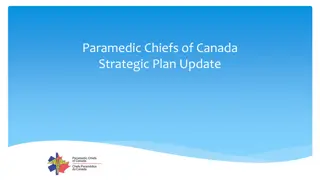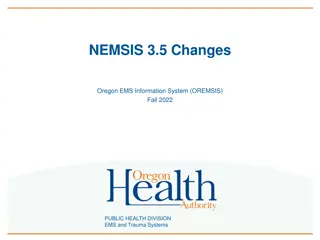Arkansas Tech University Ozark Campus Paramedic/EMS Internship Information
Providing EMS education since 1996, Arkansas Tech University Ozark Campus offers an Associate of Applied Science in Paramedic/Emergency Medical Service. They have various partnerships for internship placements and emphasize the role of EMS field preceptors in guiding students. Remembering the qualities of favorite preceptors can help aspiring preceptors develop essential skills to support and educate future EMS professionals.
Download Presentation

Please find below an Image/Link to download the presentation.
The content on the website is provided AS IS for your information and personal use only. It may not be sold, licensed, or shared on other websites without obtaining consent from the author. Download presentation by click this link. If you encounter any issues during the download, it is possible that the publisher has removed the file from their server.
E N D
Presentation Transcript
Arkansas Tech University Arkansas Tech University Ozark Campus Ozark Campus Paramedic/EMS Internship and Capstone Preceptor Information
History History Providing EMS education in Ozark since 1996 Received Committee on Accreditation for Emergency Medical Service Programs Accreditation in 2003 Became part of Arkansas Tech University in 2007 Associate of Applied Science in Paramedic/Emergency Medical Service in 2013
Partnerships Partnerships Internship Locations: Madison County EMS Fort Smith EMS Russellville Fire Department Franklin County EMS Med-Tech EMS Sebastian County EMS Johnson County EMS (JRMC) MEMS Southwest EMS Pope County EMS LifeNet EMS Logan County EMS
Role of the EMS Field Preceptor Role of the EMS Field Preceptor Be knowledgeable of subject matter Document students progress Provide constructive criticism and feedback Perform as the instructors eyes and ears in the field Share knowledge and past experiences Maintain a high degree of professionalism
Please Remember Please Remember Be mindful of war stories Preceptors are role models that others strive to emulate. Students may try to jump from A to C without considering B. Preceptors do not have to have all the answers Research tools (Textbooks, quick reference guides, helpful apps, etc.) Peers Other medical professionals (physicians, specialists, etc.)
Think About It Think About It Who was your favorite preceptor(s) What qualities did he/she/they posses What was your favorite thing about them and their teaching style, how did they help you learn? Who was your least favorite and why? Now, do you want to emulate your favorite or least favorite?
Qualities of a Preceptor Qualities of a Preceptor Knowledgeable in subject matter Relation from classroom to field Confidence Encourage/motivate students Socialization to the world of EMS and Healthcare
Learning Types Learning Types Preceptors should be able to adapt to each of the three student learning types Auditory Can assimilate information from lecture Hear one Visual Need to observe a demonstration See one Kinesthetic Must perform a skill Do one
Teaching Tools Teaching Tools Experiential Learning Ambulance Calls Patient Contacts Scenario Based Teaching Q/A Run Reviews Be mindful of HIPAA Evaluations Student Lab Manual Student Shift Evaluations
Learning Domains Learning Domains Cognitive Mental Skills Knowledge Psychomotor Physical skills Skills Affective Growth in feelings or emotional areas Attitude
Level 1 Cognitive Level 1 Cognitive Cognitive Remembering Recall or retrieve previous learned information Understanding Comprehend meaning of instructions and problems State a problem in one s own words
Level 2 Cognitive Level 2 Cognitive Cognitive Applying Applies what was learned in the classroom into situations in the work place Analyzing Distinguishes between facts and inferences
Level 3 Cognitive Level 3 Cognitive Cognitive Evaluating Decide on the most effective solution Creating Integrate training from several sources to solve a problem
Level 1 Psychomotor Level 1 Psychomotor Psychomotor Imitation Performing a skill while observing a demonstrator Manipulation Performing certain actions by memory or instructions
Level 2 Psychomotor Level 2 Psychomotor Psychomotor Precision Perform a skill or task without assistance Demonstrate a task to a beginner Articulation Combining a series of skills to meet a requirement
Level 3 Psychomotor Level 3 Psychomotor Psychomotor Naturalization Mastering a high level of performance without needing to think much about it
Level 1 Affective Level 1 Affective Affective Receiving Phenomena Listening to others with respect Responding to Phenomena Participate in discussions Questions ideals in order to understand them
Level 2 Affective Level 2 Affective Affective Valuing Informs preceptor on matters that one feels strongly about Organization Accepts responsibility for one s behavior Prioritizes time effectively
Level 3 Affective Level 3 Affective Affective Characterization Displays teamwork Displays a commitment to ethical practice
Measure Progress Measure Progress Students should work their way to the higher levels of the learning domains throughout their time in internship, receiving an evaluation from the preceptor after every field shift Phase 1 & 2 end evaluations Phase 1-Student moves through level 1 & 2 cognitive, psychomotor, and affective learning levels and is evaluated for progression to capstone Phase 2-Also known as capstone, student is expected to perform at the highest level in cognitive, psychomotor, and affective domains, acting as team leader on all calls Progression is monitored by preceptor and clinical coordinator via student evaluations
Student Evaluations Student Evaluations Preceptor Evaluation of Student Every Shift Phase 1 Preceptor Evaluation of Student used by preceptor for progression of student into capstone phase Phase 2 Preceptor Evaluation of student used to evaluate student as competent entry level provider at the end of capstone experience
Preceptors and Sites are Evaluated as Well! Preceptors and Sites are Evaluated as Well! Internship Student Evaluation of Preceptor Internship Student Evaluation of Site
Forms and Manuals Forms and Manuals Preceptor Agreement Must Be Signed by Preceptor Site Personnel Internship Handbook Student Evaluation Internship Site Evaluation Student Evaluation of Preceptor Preceptor Evaluation Preceptors Evaluation of Student Link to all student/preceptor internship documents: http://www.atu.edu/ozark/academics/preceptor.php
Summary Summary You are our educators in the internship/capstone setting Help our students integrate their knowledge into field practice Continuous evaluation is key to student success You are helping to shape your peers, coworkers, and medical providers of tomorrow
Arkansas Tech, Ozark Campus Paramedic/EMS Department is proud of our community partnerships. We take pride in partnering with excellent clinical sites that provide extensive access, allowing students to have the best possible opportunity for success and growth while enrolled in our program. Thank you for your time and commitment to EMS education! www.atu.edu/ozark www.atu.edu/ozark
References References Baltimore, J. J. (2004). The Hospital Clinical Preceptor: Essential Preparation for Success. The Journal of Continuing Education in Nursing, 133. Clark, D. (2014, July 7). Bloom's Taxonomy of Learning Domains. Retrieved October 2, 2014, from Big Dog & Little Dog's Performance Juxtaposition: http://www.nwlink.com/~donclark/hrd/bloom.html#psychomotor Walker, S. (2011, Sept. 26). TVCC EMS Preceptor Orientation. Retrieved October 2, 2014, from Trinity Valley Community College: https://www2.tvcc.edu/Health-Science- Center/healthscience/EMSPreceptorOrientation/index.html























